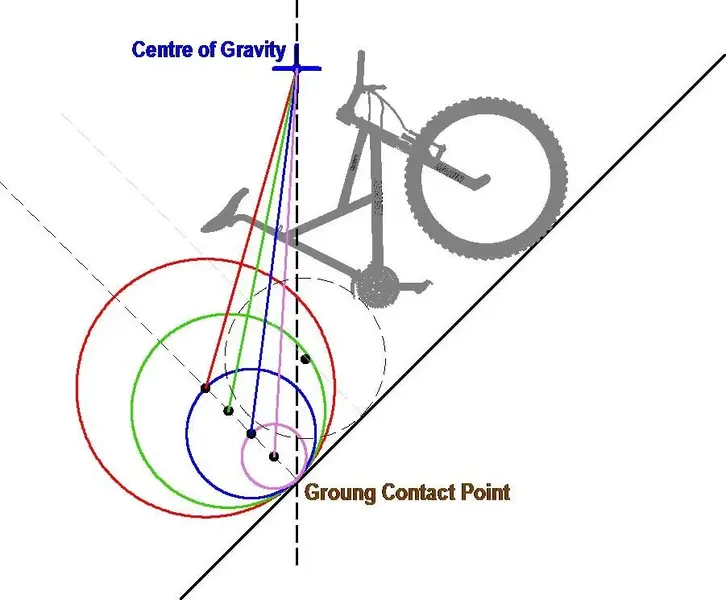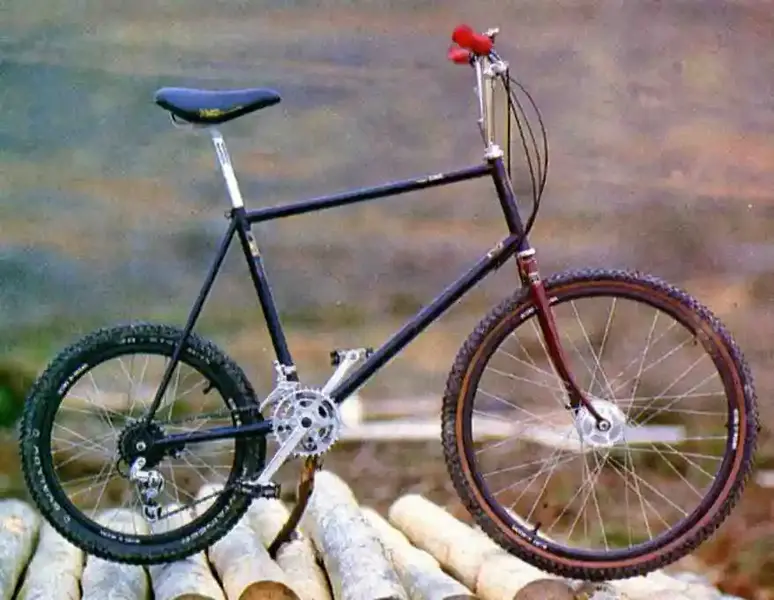Perhaps the frame design does come into it also...my Santa Cruz 29er has an "s" bend in the seat tube that brings the rear wheel forward more under the saddle. A bit like the retro Alpinestars E-stay bikes that say that tucking the wheel under the saddle more helps with climbing. Perhaps the stem length also comes into it, on my 29er I have an 80mm stem which keeps the front wheel grounded too.
You are using an out of date browser. It may not display this or other websites correctly.
You should upgrade or use an alternative browser.
You should upgrade or use an alternative browser.
Do bigger wheels climb steeper hills?
- Thread starter GrahamJohnWallace
- Start date
- Feedback
- View
Yes.
For a given slope there will definitely be an optimal relationship between the relative positions of:
*the centre of Mass
*the rear axle
*probably the ground contact point
With large wheels, bending seat tubes may well be crucial. We may even end up by coming to the conclusion that bendy seat tube bikes can climb steeper slopes.
One possibility is that all wheel sizes are equally good as long as you optimise the frame geometry for them.
For a given slope there will definitely be an optimal relationship between the relative positions of:
*the centre of Mass
*the rear axle
*probably the ground contact point
With large wheels, bending seat tubes may well be crucial. We may even end up by coming to the conclusion that bendy seat tube bikes can climb steeper slopes.
One possibility is that all wheel sizes are equally good as long as you optimise the frame geometry for them.
GrahamJohnWallace":pas1meqa said:Yes.
One possibility is that all wheel sizes are equally good as long as you optimise the frame geometry for them.
That I think is the key....a lot is down to rider build too..
- Feedback
- View
wookiee":4sqixt4p said:That I think is the key....a lot is down to rider build too..GrahamJohnWallace":4sqixt4p said:Yes.
One possibility is that all wheel sizes are equally good as long as you optimise the frame geometry for them.
I should be able to test this by making a series of drawings of identical bikes apart from their rear wheel size and rear geometry. The rear geometry of each will be optimal for say, a 45 degree incline. Optimal will mean that each bike will be balanced (in equilibrium) for that incline, in the same way that a Segway must be in equilibrium in order to balance. Each diagram will show a bike at its tipping point just before it tips backwards. If these drawings can be made it will show that the tipping point of any bike is not a sole product of wheel size, but of wheel size and geometry combined.
To simplify things, I will be assuming that the bikes are traveling at constant velocity and that rear wheel traction is guaranteed.
- Feedback
- View
Sorry for the delay in posting this but lately, I have been doing more riding than theorising.
This Diagram shows the same tipping point for 4 different wheel sizes. Notice that the centre of gravity is directly above the 'ground contact point' for each size of wheel.
It shows that the tipping point is not solely determined by wheel size, but by axle position and wheel size combined.
It also suggests that a bike can be engineered to have a certain tipping angle, in this case 45 degrees, whatever its wheel size. But to engineer a bike to climb steep slopes will put less weight over the rear wheel when the bike is traveling on the flat.
Conversely, this English Cycles' 'Rat' should have good rear end traction on the flat but a small tipping angle because of its very short rear end.
Same diagram, but the bike has been replaced by a weight representing the combined centre of mass of the rider and bike.
This Diagram shows the same tipping point for 4 different wheel sizes. Notice that the centre of gravity is directly above the 'ground contact point' for each size of wheel.
It shows that the tipping point is not solely determined by wheel size, but by axle position and wheel size combined.
It also suggests that a bike can be engineered to have a certain tipping angle, in this case 45 degrees, whatever its wheel size. But to engineer a bike to climb steep slopes will put less weight over the rear wheel when the bike is traveling on the flat.
Conversely, this English Cycles' 'Rat' should have good rear end traction on the flat but a small tipping angle because of its very short rear end.
Same diagram, but the bike has been replaced by a weight representing the combined centre of mass of the rider and bike.
Attachments
Similar threads
- Replies
- 2
- Views
- 232
- Replies
- 8
- Views
- 718
- Poll
- Replies
- 64
- Views
- 2K


